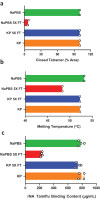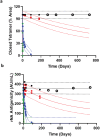Formulation development of a stable influenza recombinant neuraminidase vaccine candidate
- PMID: 38497413
- PMCID: PMC10950269
- DOI: 10.1080/21645515.2024.2304393
Formulation development of a stable influenza recombinant neuraminidase vaccine candidate
Abstract
Current influenza vaccines could be augmented by including recombinant neuraminidase (rNA) protein antigen to broaden protective immunity and improve efficacy. Toward this goal, we investigated formulation conditions to optimize rNA physicochemical stability. When rNA in sodium phosphate saline buffer (NaPBS) was frozen and thawed (F/T), the tetrameric structure transitioned from a "closed" to an "open" conformation, negatively impacting functional activity. Hydrogen deuterium exchange experiments identified differences in anchorage binding sites at the base of the open tetramer, offering a structural mechanistic explanation for the change in conformation and decreased functional activity. Change to the open configuration was triggered by the combined stresses of acidic pH and F/T. The desired closed conformation was preserved in a potassium phosphate buffer (KP), minimizing pH drop upon freezing and including 10% sucrose to control F/T stress. Stability was further evaluated in thermal stress studies where changes in conformation were readily detected by ELISA and size exclusion chromatography (SEC). Both tests were suitable indicators of stability and antigenicity and considered potential critical quality attributes (pCQAs). To understand longer-term stability, the pCQA profiles from thermally stressed rNA at 6 months were modeled to predict stability of at least 24-months at 5°C storage. In summary, a desired rNA closed tetramer was maintained by formulation selection and monitoring of pCQAs to produce a stable rNA vaccine candidate. The study highlights the importance of understanding and controlling vaccine protein structural and functional integrity.
Keywords: CQA; Vaccine; antigenicity; conformational stability; freezing/thawing; neuraminidase; recombinant.
Conflict of interest statement
This work was funded by Sanofi. At the time of preparation all authors were employees of Sanofi and may hold shares and/or stock options in the company.
Figures






References
Publication types
MeSH terms
Substances
LinkOut - more resources
Full Text Sources
Other Literature Sources
Medical
